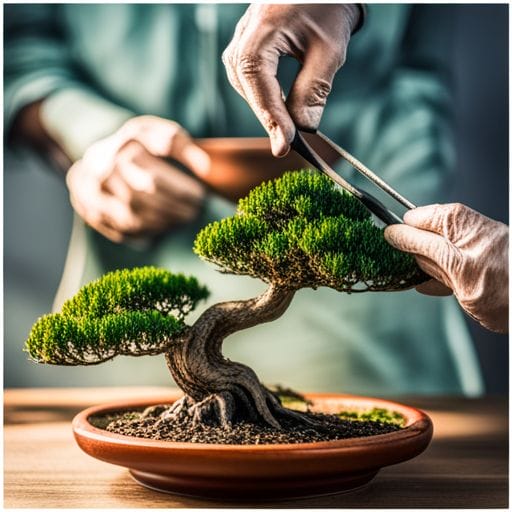Bonsai trees, renowned for their intricate cultivation techniques and small size, can also exhibit surprisingly fast growth. This article explores the various species that are known for their rapid growth, including the Weeping Willow, Quaking Aspen, Red Maple, Ficus, Redwood, and more. These trees possess unique characteristics and are abundant in different regions of North America.
The Weeping Willow, for example, is particularly suitable for bonsai and can live for over a century. To achieve fast growth, bonsai enthusiasts consider factors such as species’ wide root systems and their ability to efficiently absorb nutrients and water. Moreover, proper care and maintenance, including re-potting, well-managed drainage, watering routines, root pruning, and suitable soil, are crucial for the accelerated growth of bonsai trees.
By providing these optimal conditions, bonsai trees can thrive and grow remarkably quickly. This article will provide valuable insights and tips for those seeking to cultivate fast-growing bonsai trees.
Contents
- 1 Quick Points
- 2 Types of Fast-Growing Bonsai Trees
- 3 Factors Affecting Growth
- 4 Care and Maintenance Tips
- 5 Frequently Asked Questions
- 5.1 Can any type of tree be turned into a bonsai tree?
- 5.2 How long does it take for a bonsai tree to reach its full size?
- 5.3 Are there any special techniques or tools required for pruning the roots of a bonsai tree?
- 5.4 Can bonsai trees be grown indoors or do they require outdoor conditions?
- 5.5 Are there any specific pests or diseases that commonly affect fast-growing bonsai trees?
Quick Points
- Bonsai trees such as Weeping Willow, Quaking Aspen, Red Maple, Ficus, and Redwood are known for their fast growth.
- Factors such as wide root systems and efficient nutrient absorption contribute to the rapid growth of bonsai trees.
- Proper care and maintenance, including re-potting, well-managed drainage, proper watering routine, root pruning, and suitable soil, are crucial for accelerated growth.
– Understanding and implementing these factors are key to successfully cultivating fast-growing bonsai trees.
Types of Fast-Growing Bonsai Trees

The types of fast-growing bonsai trees, including willow, aspen, maple, ficus, and redwood, have wide root systems and efficient nutrient absorption, allowing for their rapid growth. These trees possess characteristics that make them ideal for bonsai enthusiasts who desire quick results.
The weeping willow, known for its graceful appearance, has a lifespan of over 100 years and thrives in bonsai cultivation.
Quaking aspen, a deciduous tree abundant in the Mountainous western United States, also exhibits fast growth.
Red maple, native to eastern and central North America, can reach heights of over 100 feet and is highly adaptable to bonsai techniques.
Ficus trees, particularly popular for their mature-looking bonsai forms, are well-suited for rapid growth due to their ability to absorb nutrients and water efficiently.
Lastly, the redwood, with its comprehensive root system, can grow over 320 feet tall, making it an excellent choice for those seeking fast-growing bonsai trees.
Factors Affecting Growth

Factors such as re-potting, well-managed drainage, proper watering routine, root pruning, and suitable soil significantly impact the development and progression of bonsai tree species.
Re-potting is essential to prevent root-bound conditions and provide fresh nutrients.
Well-managed drainage ensures that excess water is efficiently removed to prevent root rot.
A proper watering routine is crucial to maintain the right moisture level for the bonsai tree’s roots.
Root pruning helps stimulate new growth and maintain the tree’s size and shape.
Suitable soil composition, rich in organic matter and well-draining, promotes healthy root development and nutrient absorption.
By supplying these conditions, bonsai tree owners can facilitate faster growth and ensure the overall well-being of their trees.
Understanding and implementing these factors are key to successfully cultivating and nurturing bonsai trees.
Care and Maintenance Tips

Implementing proper care and maintenance practices is essential for the successful cultivation and development of bonsai tree species. To ensure the speedy growth of bonsai trees, several factors need to be considered.
Firstly, re-potting the tree is crucial as it provides fresh nutrients and promotes root growth.
Secondly, well-managed drainage is necessary to prevent waterlogging and root rot.
Proper watering routine is also important, as bonsai trees require regular but not excessive watering.
Root pruning helps maintain a compact root system and encourages new growth.
Lastly, selecting suitable soil that provides adequate drainage and nutrient retention is vital.
By providing these necessary conditions, bonsai enthusiasts can enhance the growth rate of their trees and ensure their longevity.
Frequently Asked Questions
Can any type of tree be turned into a bonsai tree?
Yes, any type of tree can be turned into a bonsai tree. Bonsai is the art of cultivating miniature trees, and it can be done with various species by carefully controlling their growth through pruning and other techniques.
How long does it take for a bonsai tree to reach its full size?
The time it takes for a bonsai tree to reach its full size depends on various factors such as the species, growth rate, and care provided. It can range from several years to decades.
Are there any special techniques or tools required for pruning the roots of a bonsai tree?
Special techniques and tools are required for pruning the roots of a bonsai tree. These include root shears, root hooks, and concave cutters. Techniques such as root pruning, root washing, and root combing are used to maintain the health and shape of the bonsai tree.
Can bonsai trees be grown indoors or do they require outdoor conditions?
Bonsai trees can be grown indoors or outdoors depending on the species and its specific requirements. Factors such as light, temperature, humidity, and space need to be considered to ensure the tree’s health and growth.
Are there any specific pests or diseases that commonly affect fast-growing bonsai trees?
Fast-growing bonsai trees, such as willow, aspen, maple, ficus, and redwood, can be susceptible to various pests and diseases. Common issues include aphids, scale insects, root rot, and fungal infections. Regular monitoring and proper care can help prevent and address these problems.




